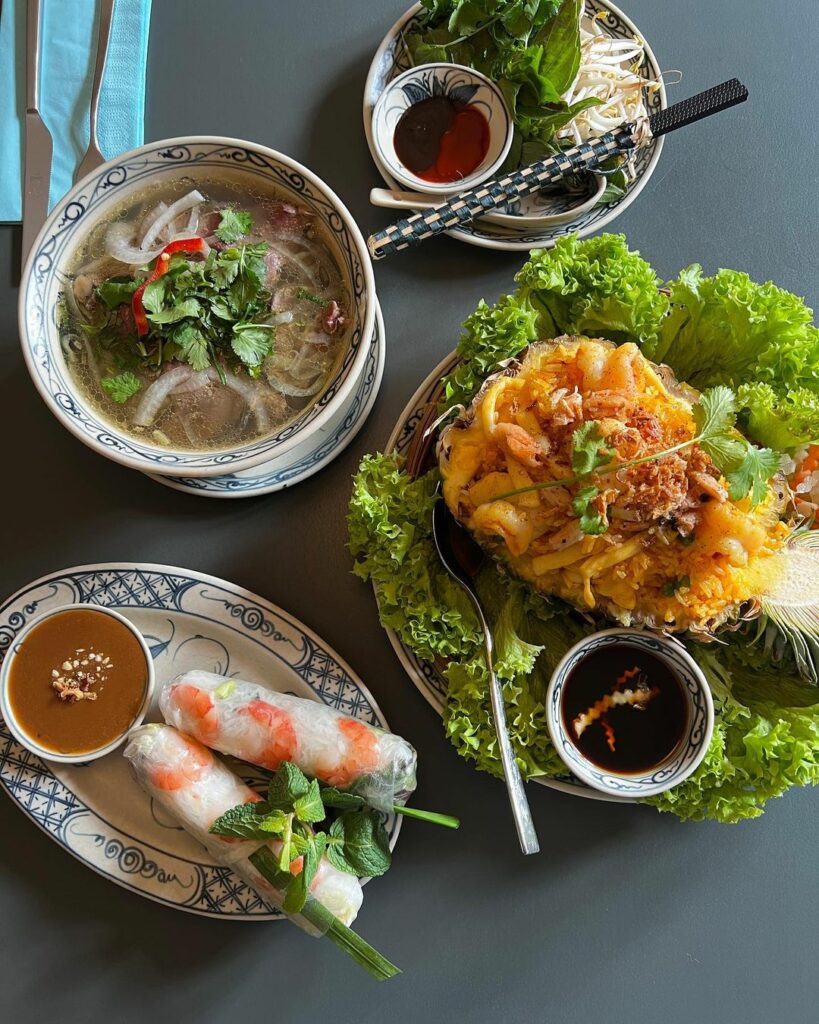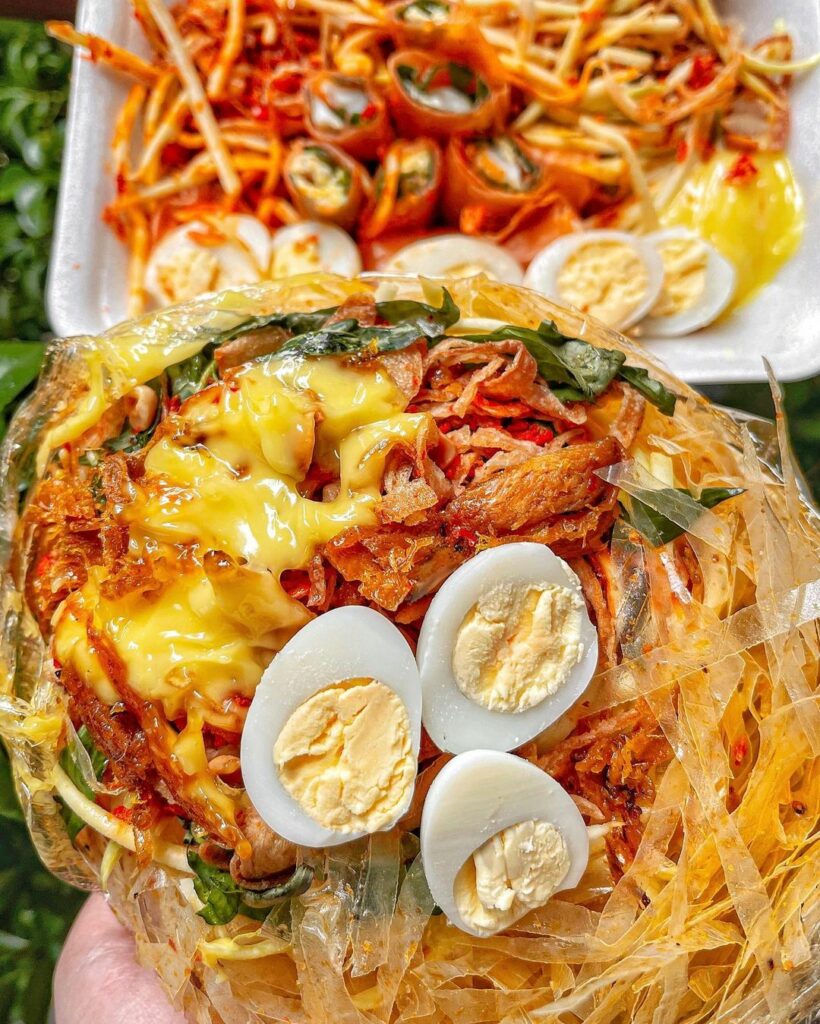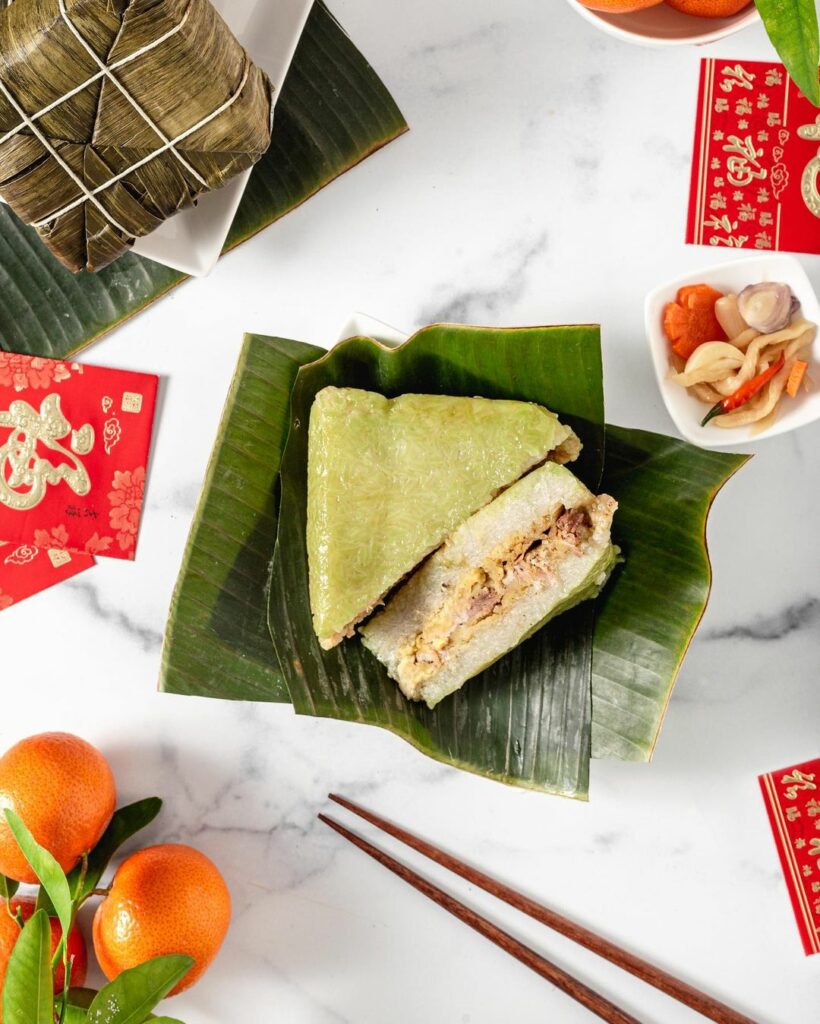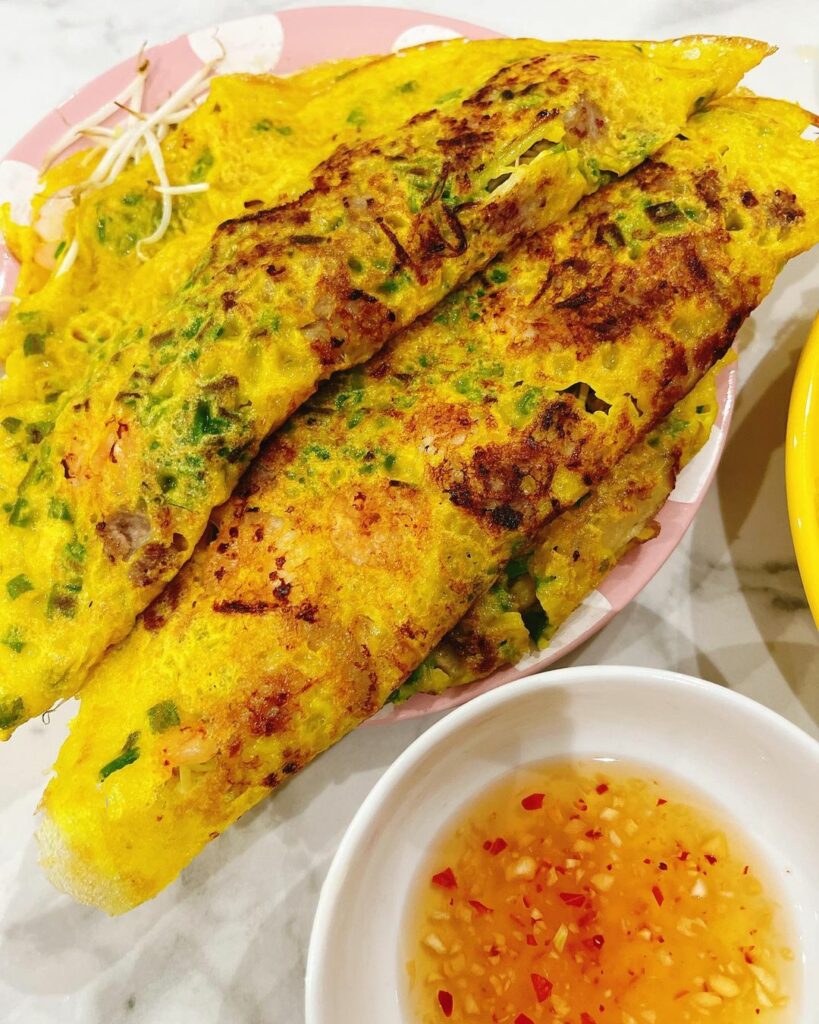Vietnamese cuisine is known for its intricate flavors and textures, and the snacks of Vietnam are no exception. From crispy banh xeo pancakes to refreshing goi cuon spring rolls, Vietnamese snacks are a feast for the senses. As someone who has grown up with a love for Vietnamese food, I’ve always found that the snack culture in Vietnam is particularly unique and fascinating. Not only are there traditional snacks that have been enjoyed for generations, but there are also modern twists on classic recipes and regional specialties that showcase the diversity of Vietnamese cuisine. Join me as we delve into the world of Vietnamese snacks, explore their significance in Vietnamese culture, and discover the flavors and textures that make them so special.
What are Vietnamese snacks?

Snacks in Vietnam are a diverse range of small, bite-sized foods that are often enjoyed between meals or as light snacks. They are an important part of Vietnamese cuisine and culture and are often enjoyed by family and friends. Vietnamese snacks are typically savory, but there are also sweet options available.
Snacks have significant cultural significance in Vietnam, where they are enjoyed during social gatherings and celebrations. They are often shared among family and friends and can be a way of showing hospitality and respect.
The history of Vietnamese snacks is deeply rooted in the country’s rich culinary traditions. Vietnamese snacks have been enjoyed for centuries, with many recipes passed down through generations.
Snacks are an important part of Vietnam’s street food culture, and many traditional snacks can still be found at street vendors throughout the country. Over time, Vietnamese snacks have evolved to include new ingredients and cooking techniques, resulting in a diverse range of flavors and textures. Today, snacks in Vietnam continue to play an important role in the country’s culinary landscape and are beloved by locals and visitors alike.
Why is Vietnamese food so good?
Vietnamese food is considered by many to be some of the best in the world due to its unique blend of flavors, fresh ingredients, and healthy preparation methods. Here are some reasons why Vietnamese food is so good:
- Fresh Ingredients: Vietnamese cuisine is known for its emphasis on fresh and locally sourced ingredients, including herbs, vegetables, and spices. This results in dishes that are bursting with flavor and nutrition.
- Balance of Flavors: Vietnamese dishes often feature a perfect balance of sweet, salty, sour, and spicy flavors, resulting in a complex and satisfying taste.
- Healthy Preparation: Many Vietnamese dishes are steamed, grilled, or stir-fried, making them healthier options than fried or heavily processed foods. Vietnamese cuisine also makes use of fresh herbs and vegetables, resulting in dishes that are low in fat and high in fiber.
- Cultural Influences: Vietnamese cuisine is heavily influenced by neighboring countries like China and Thailand, as well as by French colonialism. This has resulted in a unique blend of flavors and cooking techniques that sets Vietnamese food apart from other cuisines.
- Accessibility: Vietnamese food is known for its accessibility and affordability. Whether you’re dining in a high-end restaurant or at a street vendor, you can find delicious and authentic Vietnamese dishes at a reasonable price.
Vietnamese food is so good because it combines fresh and flavorful ingredients, healthy preparation methods, and a unique blend of cultural influences. It’s a cuisine that is both satisfying and good for you, making it a popular choice for foodies and health-conscious diners alike.
What are popular Vietnamese snacks?

Vietnam has a wide variety of snacks that are enjoyed by locals and visitors alike. Here are some of the most popular snacks in Vietnam:
- Banh Mi (Vietnamese baguette)
- Banh Xeo
- Pha lau
- Banh trang tron
- Nem nuong
- Bo bia
- Xoi
These are just a few examples of the many delicious snacks in Vietnam that are available. Vietnamese snack culture is diverse and flavorful, and many regional specialties are unique to certain parts of the country.
What are regional Vietnamese snacks?
Vietnamese cuisine is diverse and varied, and many regional specialties can be considered Vietnamese snacks. Here are some examples of regional Vietnamese snacks:
- Hue: Banh Khoai
- Hoi An: Cao Lau
- Hanoi: Cha Ca
- Saigon: Com Tam
Each region of Vietnam has its unique flavor profile and culinary traditions, reflected in its local snacks. By trying regional Vietnamese snacks, you can better understand the country’s diverse culinary landscape and appreciate the nuances of each region’s cuisine.
What Vietnamese New Year snacks?

Tet, or the Vietnamese Lunar New Year, is the most important holiday in Vietnamese culture, and many traditional snacks are enjoyed during this time. Here are some examples of Vietnamese New Year snacks:
- Banh Chung: A sticky rice cake filled with pork and beans, wrapped in banana leaves, and boiled for several hours. It is a symbol of the earth and is traditionally offered to ancestors during Tet.
- Mut: Candied fruits, typically made from ginger, coconut, lotus seeds, or kumquats, are often served as a sweet snack during Tet.
- Dua Hanh: Pickled onions, a popular snack during Tet that is believed to bring good luck and ward off evil spirits.
- Xoi Gac: A sticky rice dish that is colored red with the flesh of the gac fruit, which symbolizes good luck and prosperity in Vietnamese culture.
- Keo Dua: Coconut candy, made from fresh coconut milk and sugar, that is often served as a sweet treat during Tet.
- Gio Cha: A type of Vietnamese sausage made from pork and typically served as part of a traditional Tet feast.
These are just a few examples of the many snacks that are enjoyed during the Vietnamese New Year. The holiday is a time of celebration and feasting, and many families will prepare special dishes and snacks to share with loved ones during this important time of year.
Must-try Vietnamese snacks
Vietnamese snacks come in a wide variety of flavors, textures, and ingredients. Here are some examples of different types of Vietnamese snacks:
Vietnamese rice paper snacks
Vietnamese rice paper snack is a versatile ingredient that is used in many snacks in Vietnam. Here are some examples of rice paper snacks:
- Goi Cuon
- Banh Trang Tron
- Banh Trang Nuong
Vietnamese shrimp crackers
Vietnamese shrimp crackers are a popular snack in Vietnam, and they come in many different shapes and sizes. They are typically made from a mixture of shrimp, tapioca flour, and seasonings, and are deep-fried to a crispy texture. Some popular types of Vietnamese shrimp crackers include:
- Banh phong tom
- Banh phong Nha Trang
Vietnamese snacks chips
Vietnamese snacks chips are typically made from cassava or sweet potatoes and are flavored with various seasonings. Some examples include:
- Khoai Mon Chien
- Khoai Tay Chien
Vietnamese sausage snacks
Vietnamese sausage snack, or Nem, is a popular snack that comes in many different varieties. Some examples include:
- Nem Chua
- Cha Lua
Vietnamese peanut snacks
Vietnamese peanut snacks are a common ingredient in Vietnamese snacks and can be used in both sweet and savory preparations. Some examples include:
- Boiled Peanuts
- Hat Dieu Xao
Vietnamese candy snacks
Vietnamese candy snacks come in many different forms and are often flavored with coconut, sesame, or other sweet ingredients. Some examples include:
- Mut Dua
- Keo Me Xung
These are just a few examples of the many variations of Vietnamese snacks. Vietnamese cuisine is known for its diverse flavors and ingredients, and there are many unique and delicious snacks to explore.
See more:
- Banh Beo Recipe – Vietnamese Steamed Rice Cakes
- Banh Bot Loc Recipe: How Long To Steam Banh Bot Loc?
- Vietnamese Banh Tieu Recipe (Hollow Donut)
- Make Your Own Banh Duc Nong: A Delicious Vietnamese Hot Rice Cake
Tips for making Vietnamese snacks at home

Making Vietnamese snacks at home can be a fun and delicious way to explore the country’s cuisine. Here are some tips for making Vietnamese snacks at home:
Must-have ingredients
Many Vietnamese snacks rely on a few key ingredients, such as rice paper, fish sauce, and fresh herbs. Here are some ingredients that are essential for making Vietnamese snacks at home:
- Rice Paper: Used in many Vietnamese snacks, including fresh spring rolls (Goi Cuon) and rice paper salads (Banh Trang Tron).
- Fish Sauce: A pungent and flavorful sauce that is used in many Vietnamese dishes, including marinades, dressings, and dipping sauces.
- Fresh Herbs: Vietnamese cuisine makes use of a variety of fresh herbs, such as mint, cilantro, and Thai basil, which add brightness and flavor to many dishes.
- Rice Noodles: Used in many Vietnamese snacks and dishes, such as noodle soups (Pho) and vermicelli bowls (Bun).
- Shrimp and Pork: Two of the most common proteins used in Vietnamese snacks, such as grilled pork meatballs (Nem Nuong) and shrimp-filled rice flour rolls (Banh Cuon).
Essential kitchen tools
Some snacks in Vietnam require specialized kitchen tools, while others can be made with basic equipment. Here are some essential kitchen tools for making Vietnamese snacks:
- Rice Cooker: A rice cooker is a convenient tool for cooking rice, which is a staple ingredient in many Vietnamese snacks and dishes.
- Steamer: Used for steaming rice flour rolls (Banh Cuon) and other steamed snacks.
- Mortar and Pestle: Used for grinding herbs, spices, and other ingredients, such as garlic and chili, which are commonly used in Vietnamese cuisine.
- Wok or Skillet: Used for stir-frying ingredients and creating flavorful sauces and marinades.
Basic techniques and tips
Here are some basic techniques and tips for making Vietnamese snacks at home:
- Prep Ingredients Ahead of Time: Many Vietnamese snacks require some prep work, such as soaking rice paper or cooking rice noodles. Prepping ingredients ahead of time can save time and make the cooking process smoother.
- Use Fresh Herbs: Fresh herbs are an essential ingredient in many Vietnamese snacks, and using high-quality herbs can make a big difference in the flavor of the dish.
- Don’t Overstuff Rice Paper Rolls: When making rice paper rolls (Goi Cuon), it’s important not to overstuff them, as this can cause them to tear and fall apart.
- Use High Heat for Stir-Frying: Vietnamese cuisine often relies on high heat for stir-frying ingredients, which helps to create a flavorful char and a crisp texture.
- Experiment with Seasonings: Vietnamese cuisine is known for its complex and nuanced flavors, so don’t be afraid to experiment with different seasonings and flavor combinations to find your own unique twist on traditional Vietnamese snacks.
With these tips, you can make delicious and authentic Vietnamese snacks in the comfort of your own home.
Some Vietnamese snacks recipes
Vietnamese snacks are very diverse so, I will tell you some of the easiest recipes for making Vietnamese snacks recipes at home:
Rice paper snack: Goi Cuon (Fresh Spring Rolls)
- Fill a large bowl with warm water. Dip one rice paper wrapper in the water for about 10 seconds, or until softened.
- Lay the softened rice paper wrapper on a clean work surface. Arrange some of the shrimp, rice noodles, lettuce, bean sprouts, herbs, cucumber, carrot, and scallions on the bottom third of the wrapper.
- Fold the sides of the wrapper over the filling, then roll up tightly to form a spring roll. Repeat with the remaining rice paper wrappers and filling.
- Serve the spring rolls with peanut sauce or hoisin dipping sauce.
Related: How to Make Authentic Vietnamese Egg Rolls at Home
Shrimp crackers: Banh Phong Tom
- Place the shrimp in a food processor and pulse until finely chopped.
- In a mixing bowl, combine the chopped shrimp, tapioca flour, water, salt, and pepper. Mix until well combined.
- Heat about 1 inch of oil in a deep skillet or wok over medium-high heat.
- Drop spoonfuls of the shrimp mixture into the hot oil, pressing down slightly to flatten.
- Fry the shrimp crackers until golden brown and crispy, about 1–2 minutes per side.
- Drain the shrimp crackers on a paper towel-lined plate, and serve.
Sausage Snack: Nem Chua
- In a mixing bowl, combine the ground pork, rice vinegar, fish sauce, sugar, garlic, scallions, cilantro, Thai basil, mint leaves, and red pepper flakes (if using). Mix until well combined.
- Cover the bowl with plastic wrap and refrigerate for at least 1 hour, or overnight.
- When ready to cook, cut the banana leaves into small squares. Take about 1 tablespoon of the pork mixture and form it into a small sausage shape. Wrap the sausage in a banana leaf square and tie the ends with kitchen twine.
- Repeat with the remaining pork mixture and banana leaves.
- Steam the sausage snacks for 10–15 minutes, or until fully cooked.
- Serve the sausage snacks hot or at room temperature.
These Vietnamese snack recipes are just a few examples of the many delicious and flavorful snacks you can find in Vietnamese cuisine. Experiment with different ingredients and flavors to create your own unique Vietnamese-inspired snacks at home.
How to store Vietnamese snacks?
Proper storage is important for maintaining the freshness and flavor of Vietnamese snacks. Here are some tips for storing Vietnamese snacks:
- Rice paper snacks, such as fresh spring rolls (Goi Cuon) and rice paper salads (Banh Trang Tron), should be stored in an airtight container in the refrigerator. They will typically last for up to 2-3 days.
- Shrimp crackers and chips should be stored in an airtight container at room temperature. They can last for several weeks if stored properly.
- Sausage snacks, such as Nem Chua and Cha Lua, should be wrapped tightly in plastic wrap and stored in the refrigerator. They will typically last for up to a week.
- Peanut and candy snacks should be stored in an airtight container at room temperature. They will typically last for several weeks if stored properly.
Tips for storage
Here are some general tips for storing Vietnamese snacks:
- Keep snacks away from heat and moisture, which can cause them to spoil or lose their texture.
- Use airtight containers or plastic wraps to help preserve freshness and prevent odors from contaminating the snacks.
- If you plan to store snacks for an extended period of time, consider freezing them in airtight containers to maintain their quality.
- For optimal freshness, consume snacks within their recommended storage timeframes.
Where to buy Vietnamese snacks in the US?
Vietnamese snacks are becoming increasingly popular in the US, and there are several places where you can purchase them. Here are some options for where to buy Vietnamese snacks in the US:
Asian Grocery stores
Asian grocery stores are a great place to find a wide variety of Vietnamese snacks. These stores typically carry many different brands and types of snacks, including rice paper, shrimp crackers, candy, and more. Some popular Asian grocery store chains in the US include H Mart, 99 Ranch Market, and Pacific Ocean Marketplace.
Online retailers
Several online retailers specialize in Vietnamese snacks and other Asian foods. Some popular options include:
- Snackoo
- Asian Food Grocer
- Amazon
Vietnamese markets and bakeries
In some areas, there may be Vietnamese markets and bakeries that sell a variety of Vietnamese snacks. These shops may carry homemade or locally sourced snacks, as well as imported snacks from Vietnam.
Farmers’ Markets and Food Festivals
Farmers’ markets and food festivals can be great places to discover new Vietnamese snacks and other foods. These events often feature local vendors who sell a variety of snacks and dishes from different cultures, including Vietnamese cuisine.
By exploring these different options, you can find a wide variety of delicious Vietnamese snacks to try in the US.
FAQs
Are Vietnamese snacks healthy?
Like any cuisine, the healthiness of Vietnamese snacks depends on the specific ingredients and preparation methods used. However, many Vietnamese snacks are made with fresh, whole-food ingredients, such as herbs, vegetables, and lean proteins like shrimp and pork.
Additionally, many Vietnamese snacks are low in sugar and saturated fat, making them a healthier option than many other types of snacks.
Are Vietnamese snacks typically sweet or savory?
Vietnamese snacks can be either sweet or savory, depending on the specific type of snack. Some popular sweet snacks include coconut candy (Mut Dua) and sesame candy (Keo Me Xung), while savory snacks include shrimp crackers (Banh Phong Tom) and grilled pork meatballs (Nem Nuong).
How difficult are Vietnamese snacks to make at home?
The difficulty level of making Vietnamese snacks at home depends on the specific snack and the cook’s skill level. Some snacks, such as boiled quail eggs and roasted peanuts, are very simple to make and require minimal prep work. Other snacks, such as rice paper rolls (Goi Cuon) and steamed rice flour rolls (Banh Cuon), may require more time and effort. However, with the right ingredients and techniques, many Vietnamese snacks can be made at home with relative ease.
Conclusion
Finally, Vietnamese snacks are a delicious and diverse part of the country’s cuisine. From rice paper rolls and shrimp crackers to sweet coconut candies and sesame snacks, Vietnamese snacks come in a variety of flavors, textures, and ingredients. They are a significant part of Vietnamese culture and are enjoyed as street food, festival foods, and snacks for home.
Making Vietnamese snacks at home can be a fun and rewarding experience, and with the right ingredients and techniques, many snacks can be made with relative ease. It is important to store snacks in Vietnam properly to maintain their freshness and flavor, and to be mindful of the ingredients and preparation methods used for optimal healthiness. Whether you are exploring Vietnamese cuisine for the first time or are a seasoned fan of the country’s food, Vietnamese snacks are a must-try for anyone interested in discovering new and delicious flavors.
More Vietnamese snack recipe: Vietnamese Pate Chaud